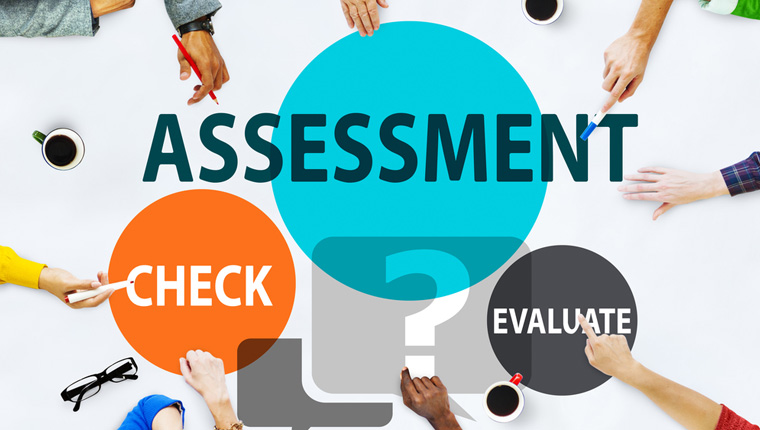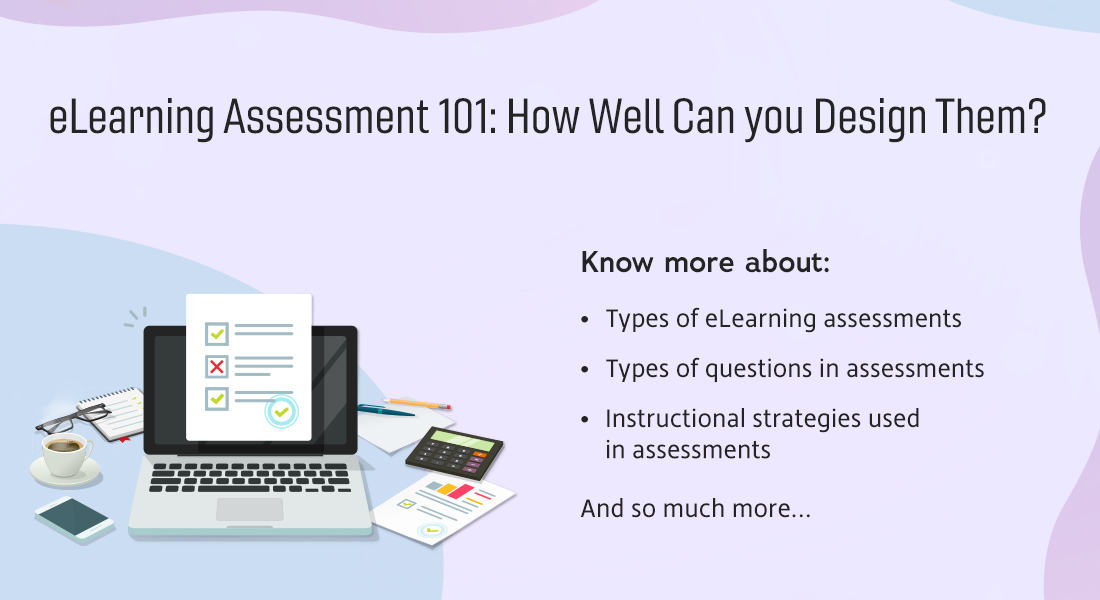The Top 4 Formats of eLearning Assessments – Design Considerations to Follow

Imagine an eLearning course without assessments. All the learner has to do is take up the course, slide by slide, module by module, and be done. Now that would be a pretty dull learning experience. How are we even going to measure the learning outcomes achieved by learners?
Design Considerations for 4 Types of eLearning Assessments
1. True/False
- Ensure the question is straightforward
- Discourage guessing
- Replace radio buttons with graphical alternatives
2. Multiple Choice
- Avoid negatives and extremes
- Ensure distractors belong to the same family
- Use question format instead of partial sentences
3. Fill-In-The-Blanks
- Ensure there is only a single correct answer
- Ensure the length of the blank is uniform
4. Match the Following
- Ensure you do not provide clues
Since assessments are one of the main drivers for knowledge absorption and also the main means to assess your learners’ knowledge, they should definitely be included within an eLearning course. Well, just including them would not be enough, you would have to design them appropriately too.
The Top 4 Formats of eLearning Assessments and their Design Considerations
1. True/False eLearning Assessment
True/False questions are the ones in which a statement or a question is posed, and the learner should respond with either True or False. They are mostly used to test learners on basic facts and help them understand popular misconceptions.
Design Considerations
Ensure the Question is Straightforward
Consider the question “Do you believe the below statement is true?”
Posing such questions in eLearning assessments should be avoided. Avoid posing a question asking what the learner thinks or believes, unless that is exactly what you are testing. Always ensure the question is simple and straightforward. Instead of posing the question mentioned above, consider asking “Is the below statement true?”
Discourage Guessing
When a True/False question is used in eLearning assessments, learners tend to guess the right answer. There is in fact a 50% chance of them being right. This leads to inaccurate tracking of the learners’ understanding of a subject. Hence, you need to take measures to ensure guessing does not take place.
William Horton, the author of the book E-Learning by Design, states that one of the ways to avoid this is by penalizing guessing – i.e., award a negative score for each incorrect answer. This will deter guesswork.
Replace Radio Buttons with Graphical Alternatives
Radio buttons are often used to represent the choices within a True/False assessment. Why don’t we make the eLearning assessment interesting by using graphical alternatives instead? Here are a few graphical alternatives that can be used:

Adding such graphical alternatives will instill a sense of interest in learners, which will in turn lead to higher engagement levels.
2. Multiple Choice
Multiple choice questions are the ones in which the learner will be posed a question with a set of choices, from which they have to choose the right one/s. Based on the number of choices to be selected, multiple choice questions are of two types:
Single Select: In single select multiple choice questions, learners need to pick just one answer from the list of choices provided. This can be opted when you want your learners to point out a particular object from a category, identify the main cause of a problem, or identify the best course of action among others.
Multiple Select: In multiple select multiple choice questions, learners need to pick more than more answer from the list. This can be incorporated when your aim is for your learners to choose options that meet a particular criterion, pick examples from non-examples, or even to decide when a rule applies.
Design Considerations
Avoid Negatives and Extremes
Negative phrases such as ‘NOT’ and ‘EXCEPT’ might hinder a clear understanding for your learners; also, extremes such as ‘ALWAYS’, and ‘ONLY’. In case negative phrasing is unavoidable, ensure the negative term is in bold or italics, as otherwise learners might misread the question.
Ensure Distractors Belong to the Same Family as the Answer
Consider the question:
Who coined the term ‘atom?’
- Plato
- Democritus
- Abraham Lincoln
- Socrates
Now, one thing I am sure about is you might have completely ruled out the third choice as Abraham Lincoln is obviously not the answer. Why? That choice does not even belong to the family of early Greek philosophers.
Distractors provided in the choices of eLearning assessments should be correct enough to challenge learners to think and pick the right one. Ensure they belong to the same family as the right answer.
Use the Question Format Instead of Partial Sentences
Consider this example:
A mixture of potassium nitrate, powdered charcoal, and Sulphur is called _______.
- Cement
- Gun powder
- Aluminium
- Copper
This multiple choice is a partial sentence and not in the question format. While trying to solve the above problem, learners will have to hold this partial sentence in their mind and complete it with each of the alternatives. Instead, use a question format as that will be fairer for learners to comprehend and answer. The partial sentence can be re-written as: What is the mixture of potassium nitrate, powdered charcoal, and Sulphur called?
3. Fill-in-the Blanks
When a fill-in-the-blanks type of question is used in an eLearning assessment, learners will have to type the missing word (or number), which is the answer to the question. They are mainly used to ‘verify that learners have truly learned the names of things.’ They can be used to test the recall of abbreviations, technical terms, etc.
A fill-in-the-blank question with more than one blank to fill is called a cloze question.
Design Considerations
Ensure there is Only a Single Correct Answer
You might have come across many situations where you have to answer a fill in the blank question and are confused with a few of the answers. And often, there actually might be 2-3 correct answers to the question. Ensure this does not happen in your eLearning assessment. You cannot afford to risk confusing your learners and making the overall scoring process complicated. Ensure there is only one single correct answer to the question.
Ensure the Length of the Blank is Uniform
Uneven blanks are a path for guesswork. For instance, even if the answer is a 15-letter word or a 5-letter word, the length of the blank should not vary. The length of the blank should be standardized and even throughout.
4. Match the Following eLearning Assessment
Match the following is used to assess learners on their knowledge of the relationship between two sets of data. For example, terms and definitions, causes and effects, scenarios and consequences. The learner will have to connect a word/sentence from one column with a corresponding word/sentence in the second column.
Design Considerations
Ensure You Do Not Provide Clues
Complete the following sentences by matching the questions on the right with the answers on the left.
| 1. Igneous rocks are formed | a. with crystalline rock |
| 2. The formation of coal requires | b. a metamorphic rock |
| 3. A geode is filled | c. heat and pressure |
| 4. Feldspar is classified as | d. through the solidification of molten lava |
Well, I am pretty sure even though you might not be aware of the subject the question is based on, you still could match most of the questions correctly. Why is this? It is because hints are provided through grammar, which is in fact a dead giveaway. Hence double check to ensure this does not happen.
There are a whole lot of other types of eLearning assessments that can be included in online courses such as sequencing, drop-down assessments, and more, but the above mentioned four are the most common one’s you are likely to come across. Hence, keep these design considerations in mind and ensure your learners are indeed being assessed appropriately.



![6 Steps for Flawless eLearning Assessments [Infographic]](https://blog.commlabindia.com/hubfs/Imported_Blog_Media/eLearning-Assessments-6-Best-Practices-to-Follow.png)

